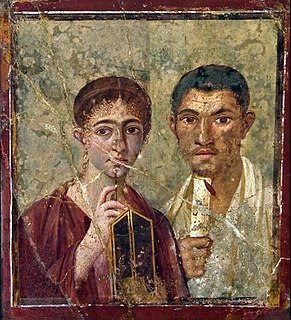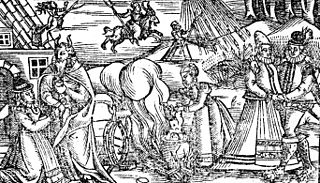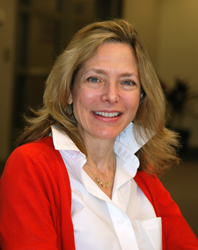Related Research Articles
Cultural bias is the phenomenon of interpreting and judging phenomena by standards inherent to one's own culture. The phenomenon is sometimes considered a problem central to social and human sciences, such as economics, psychology, anthropology, and sociology. Some practitioners of the aforementioned fields have attempted to develop methods and theories to compensate for or eliminate cultural bias.

In the study of history as an academic discipline, a primary source is an artifact, document, diary, manuscript, autobiography, recording, or any other source of information that was created at the time under study. It serves as an original source of information about the topic. Similar definitions can be used in library science, and other areas of scholarship, although different fields have somewhat different definitions. In journalism, a primary source can be a person with direct knowledge of a situation, or a document written by such a person.

Isobel Gowdie was a Scottish woman who confessed to witchcraft at Auldearn near Nairn during 1662. Scant information is available about her age or life and, although she was probably executed in line with the usual practice, it is uncertain whether this was the case or if she was allowed to return to the obscurity of her former life as a cottar’s wife. Her detailed testimony, apparently achieved without the use of violent torture, provides one of the most comprehensive insights into European witchcraft folklore at the end of the era of witch-hunts.

Historical method is the collection of techniques and guidelines that historians use to research and write histories of the past. Secondary sources, primary sources and material evidence such as that derived from archaeology may all be drawn on, and the historian's skill lies in identifying these sources, evaluating their relative authority, and combining their testimony appropriately in order to construct an accurate and reliable picture of past events and environments.
Source criticism is the process of evaluating an information source, i.e. a document, a person, a speech, a fingerprint, a photo, an observation, or anything used in order to obtain knowledge. In relation to a given purpose, a given information source may be more or less valid, reliable or relevant. Broadly, "source criticism" is the interdisciplinary study of how information sources are evaluated for given tasks.
Arthur John Brereton Marwick was a British social historian, who served for many years as Professor of History at the Open University. His research interests lay primarily in the history of Britain in the twentieth century, and the relationship between war and social change. He is probably best known, however, for his more theoretical book The Nature of History, and its greatly reworked and expanded version The New Nature of History (2001). In the latter work he defended an empirical and source-based approach towards the writing of history, and argued against the turn towards postmodernism. He believed firmly that history was "of central importance to society".

Palgrave Macmillan is a British academic and trade publishing company headquartered in the London Borough of Camden. Its programme includes textbooks, journals, monographs, professional and reference works in print and online.
Critical historiography approaches the history of art, literature or architecture from a critical theory perspective. Critical historiography is used by various scholars in recent decades to emphasize the ambiguous relationship between the past and the writing of history. Specifically, it is used as a method by which one understands the past and can be applied in various fields of academic work.

Austen Harry Albu was a British Labour Member of Parliament for Edmonton.
Richard Lawrence Leonard, known as Dick Leonard, is a British writer, journalist and former Labour Party politician. He is a pro-European social democrat and was a supporter of the late Labour Foreign Secretary Anthony Crosland who championed Gaitskellism.

History is the study of the past. Events occurring before the invention of writing systems are considered prehistory. "History" is an umbrella term that relates to past events as well as the memory, discovery, collection, organization, presentation, and interpretation of information about these events. Historians place the past in context using historical sources such as written documents, oral accounts, ecological markers, and material objects including art and artifacts.
Demographic economics or population economics is the application of economic analysis to demography, the study of human populations, including size, growth, density, distribution, and vital statistics.
Ellen Annette McArthur (1862–1927) was a British economic historian.

Susan Jolliffe Napier is a Professor of the Japanese Program at Tufts University. She was formerly the Mitsubishi Professor of Japanese Literature and Culture at the University of Texas at Austin. She also worked as a visiting professor in the Department of East Asian Languages and Civilizations at Harvard University, and in cinema and media studies at University of Pennsylvania. Napier is an anime and manga critic.
The manosphere is a collection of websites, blogs, and online forums promoting some forms of masculinity, hostility towards women, strong opposition to feminism, and exaggerated misogyny. The manosphere has been associated politically with the far-right and alt-right. Movements within the manosphere include the men's rights movement, incels, Men Going Their Own Way (MGTOW), pick-up artists (PUA), and fathers' rights groups. The manosphere has been associated with online harassment as well as some mass shootings and other real-world acts of violence, and has been implicated in radicalizing men into committing violence against women.
The philosophy of rationalism, understood as having first emerged in the writings of Francis Bacon and René Descartes, has received a variety of criticisms since its inception. These may entail a view that certain things are beyond rational understanding, that total rationality is insufficient to human life, or that people are not instinctively rational and progressive.
John Shannon Hendrix is an architectural historian and philosopher who has written and lectured extensively on the subjects of architecture, art, philosophy, aesthetics, psychoanalysis, science, culture and history. Much of his work focuses on connections among those topics, such as interactions of vision, perception, and sensation with the arts and architecture, the relationships between psychoanalysis and architecture, physical sciences and architecture, and philosophy and architecture. His career focuses on research and writing about "mostly European precedents in architecture and philosophy, for the purpose of suggesting alternatives to the practice of architecture and philosophy at the beginning of the twenty-first century."
The Cambodian–Spanish War (1593-1597) was an attempt by the Spanish Empire to conquer Cambodia, establish their own king, and Christianize the population. Along with the Spanish, Spanish Filipinos, native Filipinos, and Japanese mercenaries participated in the invasion of Cambodia.
This bibliography includes major books and articles about British prime minister Margaret Thatcher and her policies in office.
References
- 1 2 3 Clapson, Mark (2009). The Routledge Companion to Britain in the Twentieth Century. Oxon: Routledge. p. 231. ISBN 978-0203875285.
- ↑ Marwick, Arthur (2001) [1970]. The New Nature of History: knowledge, evidence, language. Basingstoke: Palgrave. pp. 172–79. ISBN 0-333-96447-0.
- ↑ Guerlac, Henry (1963). "Some historical assumptions of the history of science". In Crombie, A. C. (ed.). Scientific change: historical studies in the intellectual, social and technical conditions for scientific discovery and technical invention, from antiquity to the present. New York: Basic Books. p. 799.
- ↑ Marwick 2001, p. 172.
- ↑ Scalambrino, Frank (2018). Philosophical Principles of the History and Systems of Psychology: Essential Distinctions. Cham: Palgrave Macmillan. p. 11. ISBN 978-3-319-74732-3.
- ↑ Giersdorf, Jens Richard; Wong, Yutian (2018). The Routledge Dance Studies Reader. Routledge. ISBN 9781351613842.
- 1 2 Scalambrino, Frank (2018). Philosophical Principles of the History and Systems of Psychology: Essential Distinctions. Cham, Switzerland: Palgrave Macmillan. pp. 11, 13. ISBN 9783319747323.
- ↑ Publishing, Speedy (2015). History Fundamentals 1 (Speedy Study Guides). Speedy Publishing LLC. p. 10. ISBN 9781681856742.
- ↑ Thompson, Willie (2004). Postmodernism and History. New York: Palgrave Macmillan. p. 38. ISBN 978-0-333-96339-5.
- ↑ Adshead-Lansdale, Janet; Layson, June (2006). Dance History: An Introduction. Oxon: Routledge. ISBN 978-1-134-87685-3.
- ↑ Chapman, James (2013-10-30). Film and History. New York: Macmillan International Higher Education. p. 77. ISBN 9780230363861.